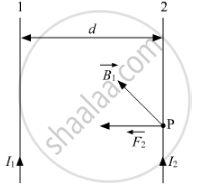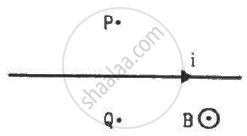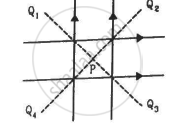Advertisements
Advertisements
प्रश्न
Two infinitely long straight parallel wires, '1' and '2', carrying steady currents I1 and I2 in the same direction are separated by a distance d. Obtain the expression for the magnetic field
उत्तर
Consider a straight conductor XY lying in the plane of paper. Consider a point P at a perpendicular distance a from straight conductor.

Magnetic field induction (B) at a point P due to current I passing through conductor XY is given by
where ϕ1 and ϕ2 are the angles made by point X and Y, respectively
At the centre of the infinite long wire, ϕ1=ϕ2=90°

Let 1 and 2 be two long infinite straight conductors. Let I1 and I2 be the current flowing through the conductor 1 and 2 and they are d distance apart from each other as shown in the figure.
The magnetic field induction (B) at a point P on conductor 2 due to current I1 passing through conductor 1 is given by
According to right hand rule, the direction of this magnetic field is perpendicular to the plane of the paper inward.
Since the conductor 2 lies in this magnetic field of conductor 1, force experienced (F2) by unit length of conductor 2 will be
F2=B1I2×1=B1I2
Conductor 1 also experiences the same amount of force, directed towards the conductor 2. Hence, conductor 1 and conductor 2 attract each other. Thus, two linear parallel conductors carrying currents in the same direction attract and repel each other, when the current flows in the opposite direction.
Let I_1=I_1=1A; r=1 m
Then,
Thus, one ampere is that value of constant current which when flowing through each of the two parallel uniform long linear conductors placed in free space at a distance of 1 m from each other will attract or repel each other with a force of 2 × 10−7 N per metre of their length.
APPEARS IN
संबंधित प्रश्न
What is the magnitude of magnetic force per unit length on a wire carrying a current of 8 A and making an angle of 30° with the direction of a uniform magnetic field of 0.15 T?
An electron is moving along the positive x-axis. You want to apply a magnetic field for a short time so that the electron may reverse its direction and move parallel to the negative x-axis. This can be done by applying the magnetic field along
(a) y-axis
(b) z-axis
(c) y-axis only
(d) z-axis only
A current of 10 A is established in a long wire along the positive z-axis. Find the magnetic field
A transmission wire carries a current of 100 A. What would be the magnetic field B at a point on the road if the wire is 8 m above the road?
A long, straight wire carrying a current of 1.0 A is placed horizontally in a uniform magnetic field B = 1.0 × 10−5 T pointing vertically upward figure. Find the magnitude of the resultant magnetic field at the points P and Q, both situated at a distance of 2.0 cm from the wire in the same horizontal plane.

Four long, straight wires, each carrying a current of 5.0 A, are placed in a plane as shown in figure. The points of intersection form a square of side 5.0 cm.
(a) Find the magnetic field at the centre P of the square.
(b) Q1, Q2, Q3, and Q4, are points situated on the diagonals of the square and at a distance from P that is equal to the diagonal of the square. Find the magnetic fields at these points.

Consider a 10-cm long piece of a wire which carries a current of 10 A. Find the magnitude of the magnetic field due to the piece at a point which makes an equilateral triangle with the ends of the piece.
Two long straight parallel conductors carrying currents I1 and I2 are separated by a distance d. If the currents are flowing in the same direction, show how the magnetic field produced by one exerts an attractive force on the other. Obtain the expression for this force and hence define 1 ampere.
Two long parallel wires kept 2 m apart carry 3A current each, in the same direction. The force per unit length on one wire due to the other is ______.
